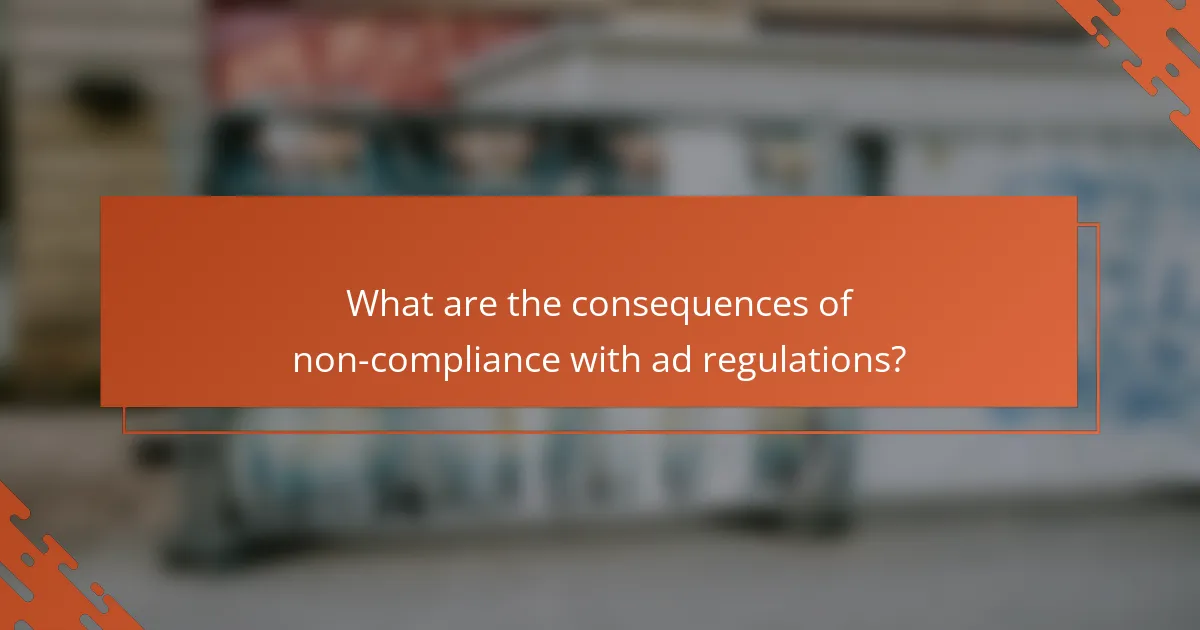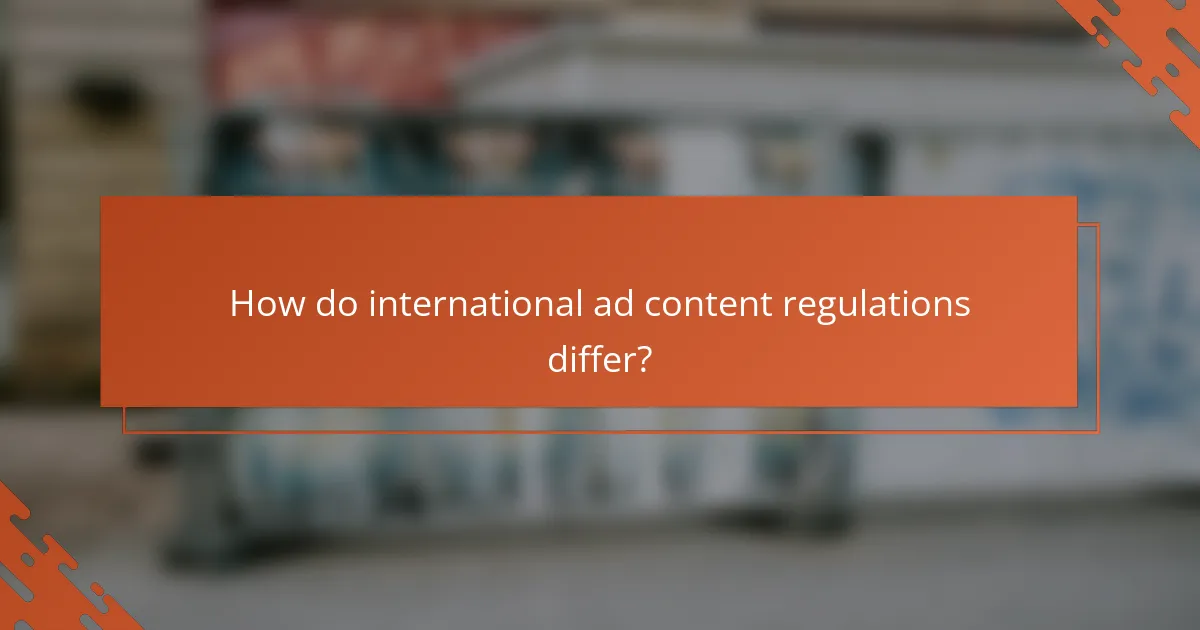Ad content regulations in the United States are designed to ensure that advertisements are truthful, not misleading, and safeguard consumer privacy. Compliance with these regulations is crucial for businesses to avoid penalties and maintain consumer trust. By implementing systematic processes such as regular audits and team training, companies can effectively adhere to legal standards while adopting best practices that emphasize transparency and accuracy in their advertising efforts.

What are the key ad content regulations in the United States?
The key ad content regulations in the United States focus on ensuring that advertisements are truthful, not misleading, and protect consumer privacy. Compliance with these regulations is essential for businesses to avoid penalties and maintain consumer trust.
Federal Trade Commission (FTC) guidelines
The Federal Trade Commission (FTC) sets forth guidelines that require advertisements to be truthful and substantiated. This means that any claims made in ads must be backed by evidence, especially for health-related products or services.
Advertisers should be aware of the importance of clear disclosures. For instance, if an endorsement is paid, it must be disclosed to avoid misleading consumers. This applies to social media influencers as well, who must clearly indicate sponsored content.
Children’s Online Privacy Protection Act (COPPA)
The Children’s Online Privacy Protection Act (COPPA) imposes strict regulations on the collection of personal information from children under 13 years old. Advertisers targeting this demographic must obtain verifiable parental consent before collecting data.
Businesses should implement clear privacy policies and ensure that their advertising practices comply with COPPA. For example, websites aimed at children must provide parents with the option to review and delete their child’s information.
Truth in Advertising regulations
Truth in Advertising regulations require that all advertising must be honest and not misleading. This includes avoiding false claims about products or services, as well as ensuring that any comparisons made are fair and substantiated.
Advertisers should regularly review their content to ensure compliance with these regulations. A common pitfall is using vague terms that could mislead consumers; instead, using specific and clear language is advisable to maintain transparency.

How can businesses ensure compliance with ad content regulations?
Businesses can ensure compliance with ad content regulations by implementing systematic processes that include regular audits, team training, and the use of compliance software. These strategies help identify potential issues and maintain adherence to legal standards.
Regular audits of advertising content
Conducting regular audits of advertising content is essential for compliance. These audits should assess whether ads meet legal requirements and align with industry standards. Aim to perform these audits quarterly or biannually to stay proactive.
During an audit, evaluate the messaging, imagery, and target audience to ensure they do not mislead or offend. Keep a checklist of common compliance issues to streamline the process and make it easier to identify areas needing improvement.
Training for marketing teams
Training marketing teams on ad content regulations is crucial for fostering a culture of compliance. Regular workshops or online courses can help team members understand the legal landscape and the importance of adhering to guidelines.
Consider developing a training program that includes case studies of past compliance failures and their consequences. This practical approach can enhance understanding and retention of key compliance concepts.
Utilizing compliance software
Utilizing compliance software can significantly streamline the process of ensuring ad content meets regulations. These tools can automate checks for compliance, flagging potential issues before ads go live.
When selecting compliance software, look for features such as real-time monitoring, reporting capabilities, and integration with existing marketing platforms. This can save time and reduce the risk of non-compliance, ultimately protecting the business from potential fines or legal action.

What are best practices for creating compliant ad content?
Best practices for creating compliant ad content involve ensuring transparency, accuracy, and respect for user privacy. Ad content should clearly disclose sponsorships, accurately represent products, and protect user data to meet regulatory standards and build trust with consumers.
Clear disclosure of sponsorships
Clear disclosure of sponsorships is essential for maintaining transparency with your audience. Advertisers should explicitly state when content is sponsored or paid for, using terms like “Sponsored by” or “Paid partnership.” This helps consumers understand the nature of the content they are viewing.
In many jurisdictions, failing to disclose sponsorships can lead to penalties. A good practice is to place disclosures at the beginning of the content or in a prominent position where they are easily visible to the audience.
Accurate representation of products
Accurate representation of products is crucial for building consumer trust and complying with advertising regulations. Advertisers must ensure that all claims about a product’s features, benefits, and performance are truthful and substantiated. Misleading claims can result in legal consequences and damage to brand reputation.
To avoid inaccuracies, consider using real customer testimonials or third-party reviews to support claims. Additionally, avoid exaggerating the benefits of a product; instead, focus on realistic outcomes that consumers can expect.
Respecting user privacy
Respecting user privacy is a fundamental aspect of compliant ad content. Advertisers should be transparent about how they collect, use, and share personal data. This includes providing clear privacy policies and obtaining consent from users when necessary.
To enhance privacy protection, consider implementing data minimization practices, where only essential information is collected. Additionally, be aware of regulations such as the General Data Protection Regulation (GDPR) in Europe, which imposes strict guidelines on data handling and user consent.

What are the consequences of non-compliance with ad regulations?
Non-compliance with ad regulations can lead to significant repercussions, including financial penalties, damage to a brand’s reputation, and potential legal action. Businesses must understand these consequences to mitigate risks and ensure adherence to advertising standards.
Fines and penalties
Fines and penalties for non-compliance can vary widely depending on the severity of the violation and the governing body involved. In many cases, fines can range from hundreds to thousands of dollars, and repeat offenders may face escalating penalties. For example, in the United States, the Federal Trade Commission (FTC) can impose fines that reach into the millions for serious infractions.
To avoid these financial repercussions, companies should regularly review their advertising practices and ensure they align with relevant regulations. Implementing a compliance checklist can help identify potential issues before they escalate into costly penalties.
Reputation damage
Reputation damage is a significant risk associated with non-compliance, as consumers may lose trust in brands that engage in misleading advertising. Negative publicity can spread quickly through social media and news outlets, leading to a decline in customer loyalty and sales. For instance, a company found guilty of false advertising may see a drop in market share as consumers turn to competitors.
To protect their reputation, businesses should prioritize transparency in their advertising efforts. Engaging with customers and addressing concerns promptly can help rebuild trust and mitigate damage from any compliance failures.
Legal action
Legal action is another potential consequence of failing to comply with advertising regulations. Consumers, competitors, or regulatory agencies may pursue lawsuits or formal complaints against companies that violate advertising laws. Such legal battles can be costly and time-consuming, often resulting in settlements or court-ordered changes to advertising practices.
To minimize the risk of legal action, businesses should consult with legal experts when developing advertising campaigns. Regular training for marketing teams on compliance issues can also help ensure that all advertising materials meet legal standards and reduce the likelihood of disputes.

What frameworks can help in evaluating ad content compliance?
Several frameworks can assist in evaluating ad content compliance, ensuring that advertisements adhere to legal and ethical standards. These frameworks provide structured guidelines and checklists that help businesses navigate the complexities of advertising regulations.
Compliance checklists
Compliance checklists serve as practical tools to ensure that all aspects of ad content meet regulatory requirements. These lists typically include items such as truthfulness, clarity, and the absence of misleading information. For instance, a checklist might require that claims made in an ad are substantiated by evidence.
When creating a compliance checklist, consider including the following key elements: target audience appropriateness, adherence to local advertising laws, and proper disclosures for sponsored content. Regularly updating the checklist can help maintain compliance as regulations evolve.
Industry-specific guidelines
Industry-specific guidelines offer tailored recommendations for advertising practices within particular sectors, such as pharmaceuticals, finance, or food and beverages. These guidelines often address unique challenges and regulatory nuances that general frameworks may overlook. For example, the pharmaceutical industry has strict rules regarding the promotion of prescription drugs, requiring clear risk disclosures.
To effectively utilize industry-specific guidelines, businesses should familiarize themselves with the relevant standards and best practices. Engaging with industry associations can provide valuable resources and updates on compliance expectations. Additionally, companies should regularly review their advertising strategies to ensure alignment with these guidelines, minimizing the risk of non-compliance.

How do international ad content regulations differ?
International ad content regulations vary significantly, primarily in terms of data protection, consumer rights, and compliance requirements. Understanding these differences is crucial for businesses operating in multiple regions to ensure they meet local legal standards.
European Union GDPR standards
The General Data Protection Regulation (GDPR) governs how businesses handle personal data in the European Union. It requires explicit consent from users before collecting their data and mandates transparency about how that data will be used.
Companies must implement stringent data protection measures and provide users with the right to access, rectify, or delete their personal information. Non-compliance can result in hefty fines, often reaching up to 4% of annual global revenue.
To comply with GDPR, businesses should conduct regular audits of their data practices, ensure clear consent mechanisms, and maintain comprehensive records of data processing activities.
Canada’s Anti-Spam Legislation (CASL)
Canada’s Anti-Spam Legislation (CASL) focuses on regulating commercial electronic messages (CEMs), requiring businesses to obtain consent before sending emails or texts. This law applies to both Canadian businesses and foreign entities targeting Canadian consumers.
CASL mandates that senders provide clear identification and an easy opt-out option in every message. Violations can lead to significant penalties, including fines that can reach millions of Canadian dollars.
To adhere to CASL, companies should maintain a robust consent management system, regularly update their contact lists, and ensure compliance with the law’s requirements for message content and sender identification.

What emerging trends are shaping ad content regulations?
Emerging trends in ad content regulations are increasingly focused on transparency, consumer protection, and the ethical use of data. As digital advertising evolves, regulators are adapting to address concerns around privacy, misinformation, and the impact of technology on consumer behavior.
Increased focus on consumer privacy
Consumer privacy is becoming a central theme in ad content regulations, driven by rising public concern over data misuse. Regulations such as the General Data Protection Regulation (GDPR) in Europe and the California Consumer Privacy Act (CCPA) in the United States emphasize the need for companies to obtain explicit consent before collecting personal data.
Advertisers must ensure that their practices align with these regulations by implementing clear privacy policies and providing users with straightforward options to manage their data preferences. Failing to comply can lead to significant fines and damage to brand reputation.
Regulations on misinformation and disinformation
Regulations targeting misinformation and disinformation are gaining traction as platforms and governments seek to protect consumers from false claims. This includes stricter guidelines on the accuracy of claims made in advertisements, particularly in sensitive areas like health and finance.
Advertisers should verify the information they present and avoid making exaggerated claims. Utilizing fact-checking resources and ensuring that all statements are backed by credible sources can help mitigate risks associated with misleading content.
Emphasis on ethical advertising practices
There is a growing emphasis on ethical advertising practices, which includes promoting inclusivity and avoiding harmful stereotypes. Advertisers are encouraged to create content that reflects diverse perspectives and does not perpetuate discrimination.
To align with these ethical standards, brands should conduct regular audits of their advertising content and seek feedback from diverse groups. This proactive approach can enhance brand loyalty and foster a positive public image.
Adaptation to new technologies
As technology evolves, so do the regulations surrounding it. Innovations such as artificial intelligence and machine learning in ad targeting raise questions about accountability and transparency. Regulators are beginning to establish frameworks to ensure that these technologies are used responsibly.
Advertisers should stay informed about the latest regulatory developments and consider how emerging technologies can be integrated into their strategies while remaining compliant. This may involve investing in training for staff on ethical AI practices and transparency in data usage.
